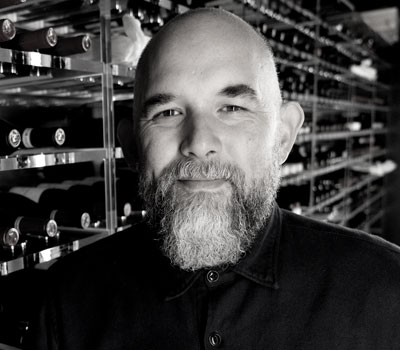After graduating from the University of Oregon with a music degree, Austin Bridges remained in Portland working his way through restaurants until he helped opened DOC as the sommelier. He focused that list on “natural wines” and built it for nine years before joining Nostrana in 2017. Now, he manages a list of more than 450 wines, half of them Italian, many leaning into organic or biodynamic farming and minimal intervention winemaking.


How is it that a bonarda from Emilia-Romagna, made by La Stoppa, turned out to be your biggest new success last year?
We’ve done events with La Stoppa in the past and we’ve found that wine is a gateway for customers who say they want a big wine. It’s an unsulfured wine, and kind of polarizing—a fairly intense wine with a lot of density. When I visited La Stoppa, we got into a discussion about their philosophy, that their wines aren’t for everybody. Their idea is that it’s not just one kind of ferment that should finish the wine. They’ll get a stuck ferment and oftentimes Brettanomyces might finish the ferment, and we find that people accept that. Also, there’s the nature of the site with a high percentage of clay, a dense soil, very deprived of nitrogen, and that imposes a distinct character in the wine. People enjoy it and now we have repeat customers who come back and order it.
What do you serve on tap?
Right now, we’re pouring Cameron’s Reserve Chardonnay from the Dundee Hills. It’s declassified from Clos Electrique. He’s also got a friulano that we’ll be tasting soon, made with long skin contact in the style of a wine from Friuli. In summer, we try to keep it simple. We get a rosé from Clos Cibonne, their Tentation, more mourvèdre and syrah and some tibouren. It’s one of those things I can sell for $9 a glass and everyone loves it.
We’re not fully in on the keg program. We appreciate the bottle experience—enjoying the wine as it opens up, checking on the wine as it ages over time. If there’s a wine I really love, I’ll keep a few cases to see how it will develop. If you start with a super-reductive chenin, what happens after six months or a year, or longer? For me, to have that understanding is important so I can improve the experience for a customer. I might hold onto something and trickle out a few bottles after a year.
How is it that a Soave, the Inama Foscarino, headed up your by-the-glass sales last year?
We meet for staff education on the second Saturday of every month, and I seize the opportunity to bring in producers. We encourage our staff to taste guests on whatever they want to taste. When we had Alessandro Inama come in, that had a huge impact. The Soave just kind of took off and I held onto it because it was pretty cool that people were drinking garganega like that.
Skerk Ograde [from Carso in Friuli] is also selling really well. It’s an orange wine that’s pretty clean. When people ask for a sauvignon blanc, we tell them we don’t have that, but here’s a wine with sauvignon blanc in it, and they try it. It was a lot harder in the DOC days. Back then, I didn’t have a single [orange] wine listed by the glass; I just opened stuff, geared around the pairings. I hoped that people would understand the wines more in the context of an eating experience. There’s a lot more momentum for orange wine now. People have tried them, they’re curious about them and are willing to spend some money on them.
Corey Warren is the Tastings Editor in addition to covering the wines of the Loire, Southern France, Argentina and South Africa.
This is a W&S web exclusive. Get access to all of our feature stories by signing up today.
















